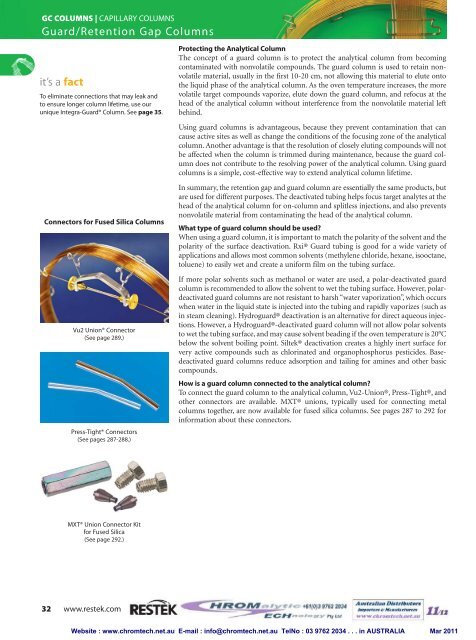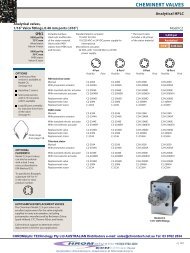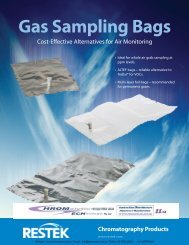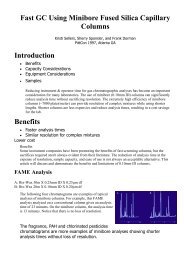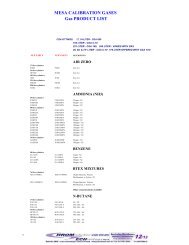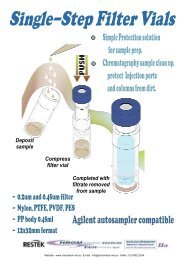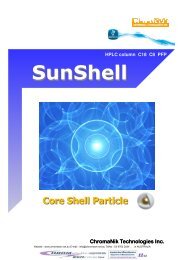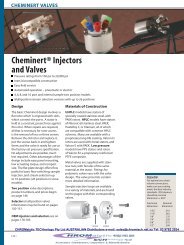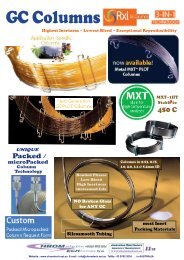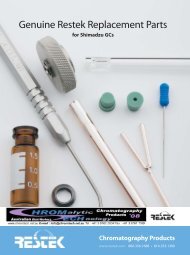gc columns
gc columns
gc columns
- No tags were found...
Create successful ePaper yourself
Turn your PDF publications into a flip-book with our unique Google optimized e-Paper software.
GC COLUMNS | CAPILLARY COLUMNSGuard/Retention Gap Columnsit’s a factTo eliminate connections that may leak andto ensure longer column lifetime, use ourunique Integra-Guard® Column. See page 35.Protecting the Analytical ColumnThe concept of a guard column is to protect the analytical column from becomin<strong>gc</strong>ontaminated with nonvolatile compounds. The guard column is used to retain nonvolatilematerial, usually in the first 10-20 cm, not allowing this material to elute ontothe liquid phase of the analytical column. As the oven temperature increases, the morevolatile target compounds vaporize, elute down the guard column, and refocus at thehead of the analytical column without interference from the nonvolatile material leftbehind.Using guard <strong>columns</strong> is advantageous, because they prevent contamination that cancause active sites as well as change the conditions of the focusing zone of the analyticalcolumn. Another advantage is that the resolution of closely eluting compounds will notbe affected when the column is trimmed during maintenance, because the guard columndoes not contribute to the resolving power of the analytical column. Using guard<strong>columns</strong> is a simple, cost-effective way to extend analytical column lifetime.Connectors for Fused Silica ColumnsVu2 Union® Connector(See page 289.)Press-Tight® Connectors(See pages 287-288.)In summary, the retention gap and guard column are essentially the same products, butare used for different purposes. The deactivated tubing helps focus target analytes at thehead of the analytical column for on-column and splitless injections, and also preventsnonvolatile material from contaminating the head of the analytical column.What type of guard column should be used?When using a guard column, it is important to match the polarity of the solvent and thepolarity of the surface deactivation. Rxi® Guard tubing is good for a wide variety ofapplications and allows most common solvents (methylene chloride, hexane, isooctane,toluene) to easily wet and create a uniform film on the tubing surface.If more polar solvents such as methanol or water are used, a polar-deactivated guardcolumn is recommended to allow the solvent to wet the tubing surface. However, polardeactivatedguard <strong>columns</strong> are not resistant to harsh “water vaporization”, which occurswhen water in the liquid state is injected into the tubing and rapidly vaporizes (such asin steam cleaning). Hydroguard® deactivation is an alternative for direct aqueous injections.However, a Hydroguard®-deactivated guard column will not allow polar solventsto wet the tubing surface, and may cause solvent beading if the oven temperature is 20°Cbelow the solvent boiling point. Siltek® deactivation creates a highly inert surface forvery active compounds such as chlorinated and organophosphorus pesticides. Basedeactivatedguard <strong>columns</strong> reduce adsorption and tailing for amines and other basiccompounds.How is a guard column connected to the analytical column?To connect the guard column to the analytical column, Vu2-Union®, Press-Tight®, andother connectors are available. MXT® unions, typically used for connecting metal<strong>columns</strong> together, are now available for fused silica <strong>columns</strong>. See pages 287 to 292 forinformation about these connectors.MXT® Union Connector Kitfor Fused Silica(See page 292.)32 www.restek.comWebsite : www.chromtech.net.au E-mail : info@chromtech.net.au TelNo : 03 9762 2034 . . . in AUSTRALIA Mar 2011


